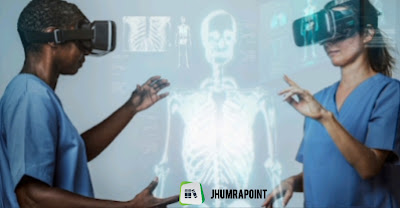Introduction:
Augmented reality (AR) is a technology that overlays digital information onto the physical world, enhancing our perception of reality. AR has been around for decades but has recently gained significant attention due to advances in technology and the widespread use of smartphones. In this blog post, we'll take a closer look at what augmented reality is, its applications, and its future potential.
What is Augmented Reality?
 |
AR is a term used to describe a real-world environment that has been augmented with virtual elements, such as images, sounds, and other sensory stimuli. AR technology uses cameras, sensors, and other components to detect the physical world and superimpose digital information onto it. This creates a hybrid environment where virtual and physical objects coexist and interact with each other in real-time.
Applications of Augmented Reality:
Education and Training
AR technology is being used in education and training to create immersive and interactive learning experiences. For example, medical students can use AR to study anatomy and practice procedures in a safe and controlled environment.
Retail and Advertising
AR is being used in retail and advertising to enhance the shopping experience and engage customers with brand messages. For example, AR can be used to display virtual product demonstrations and try-on options.
Gaming
AR has revolutionized the gaming industry by creating new and exciting ways to play games. From Pokemon Go to Harry Potter: Wizards Unite, AR games have become incredibly popular and have paved the way for a new era of gaming.
Military and Defense
AR is being used in military and defense to provide soldiers with real-time situational awareness and improve mission outcomes. For example, AR can be used to display critical information and guidance on the battlefield.
Future Potential of Augmented Reality:
Improved User Experience
As AR technology continues to evolve, it will lead to a more immersive and interactive user experience. AR will provide users with a seamless blend of digital and physical experiences, making it easier to access information and interact with the world around them.
Advancements in Healthcare
AR has the potential to revolutionize healthcare by providing doctors and medical professionals with new tools and techniques to diagnose and treat patients. For example, AR can be used to display patient information and images during surgeries to improve accuracy and outcomes.
Increased Productivity
AR can increase productivity in various industries by providing workers with new tools and techniques to complete tasks more efficiently. For example, AR can be used to display instructions and guidance in real-time, reducing the need for manual labor and minimizing mistakes.
Art and Culture
AR is being used to bring art and culture to life, allowing audiences to experience exhibits and installations in new and exciting ways. For example, AR can be used to display virtual information and interactive elements that enhance the viewing experience. |
Automotive Industry
AR has the potential to revolutionize the automotive industry by providing drivers with new and improved navigation systems and safety features. For example, AR can be used to display real-time traffic information and provide guidance to drivers on the road.
Real Estate and Construction
AR is being used in real estate and construction to visualize and plan projects, allowing designers and builders to make informed decisions and improve the building process. For example, AR can be used to display virtual renderings of buildings and properties, providing a better understanding of the finished product.
Tourism and Travel
AR is being used in tourism and travel to enhance the travel experience and provide tourists with new and innovative ways to explore new destinations. For example, AR can be used to display virtual information and interactive elements about landmarks and attractions.
The Future of AR:
The future of AR is bright, and the technology is likely to continue to evolve and improve. As AR becomes more widely adopted and integrated into our daily lives, it will lead to new and innovative uses, making our world more connected and accessible.
From smart glasses and contact lenses to wearable devices and smartphones, AR will continue to be a major player in the technology landscape. As hardware and software become more advanced, AR will become even more immersive and interactive, providing users with a seamless blend of digital and physical experiences.
Industrial and Manufacturing
AR has the potential to revolutionize industrial and manufacturing processes by providing workers with new tools and techniques to complete tasks more efficiently. For example, AR can be used to display real-time information and guidance on assembly lines, reducing the need for manual labor and minimizing mistakes.
Agriculture and Farming
AR is being used in agriculture and farming to improve crop yields and maximize productivity. For example, AR can be used to display real-time information and guidance on soil conditions, weather patterns, and crop growth.
Emergency Services and First Responders
AR is being used by emergency services and first responders to provide real-time information and guidance in critical situations. For example, AR can be used to display maps, floor plans, and other critical information to help rescue workers navigate complex environments.
Barriers to Adoption
Despite its many potential benefits, AR is not yet widely adopted due to several barriers to adoption. These include:
High Cost
The cost of AR technology remains a barrier to widespread adoption, as many AR devices and software are still expensive and inaccessible to most consumers.
Technical Complexity
AR technology can be complex and difficult to use, requiring specialized skills and knowledge to implement. This can make it difficult for businesses and individuals to adopt AR technology.
Privacy and Security Concerns
As with any technology that collects and uses personal data, there are privacy and security concerns associated with AR. These concerns must be addressed in order to ensure the widespread adoption of AR technology.






















